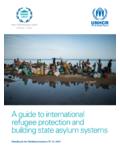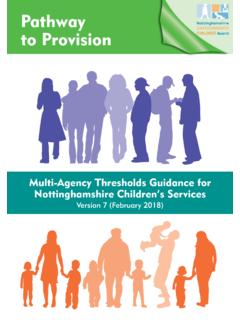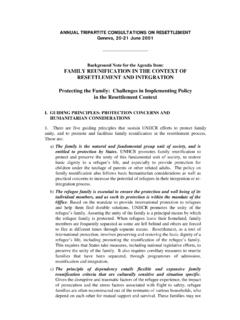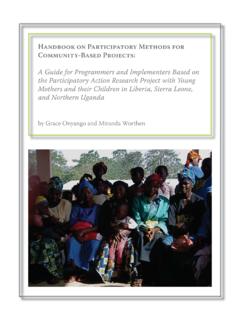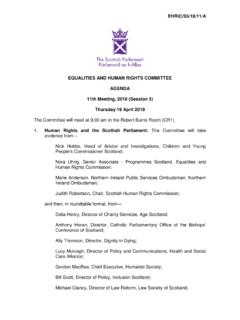Transcription of Protection Principles - Sphere Handbook
1 Protection PrinciplesHumanitarian Charter and Minimum Standards in Humanitarian Response26 How to use this chapterHumanitarian action consists of two main pillars: Protection and assistance Much of this Handbook , in particular the technical chapters, falls within the remit of assistance, while this chapter focuses on Protection Building on the Humanitarian Charter, it addresses the question of how humanitarian agencies can contribute to the Protection of those faced with the threat of violence or coercion More generally, it is concerned with the role of agencies in ensuring respect for and fulfilment of the rights articulated in the Charter, including access to assistance The chapter is divided into two sections: An introduction, which sets out the general responsibilities of all who are involved in humanitarian response to help protect the affected population and ensure respect for their rights Four Protection Principles , which underpin all humanitarian action and encompass the basic elements of Protection in the context of humanitarian response They are accompanied by guidance notes.
2 Which further elaborate the role of humanitarian agencies in Protection A reference section includes other standards and materials relating to more specialised areas of Protection 27 Protection PrinciplesContentsIntroduction 29 Protection Principles 33 References and further reading 44 Humanitarian Charter and Minimum Standards in Humanitarian Response28 Protection PrinciplesPrinciple 1 Avoid exposing people to further harm as a result of your actionsPrinciple 4 Assist with rights claims, access to remedies and recovery from abusePrinciple 2 Ensure people s access to impartial assistancePrinciple 3 Protect people from physical and psychological harm due to violence or coercionReferences and further readingHumanitarian Charter29 Protection PrinciplesIntroductionProtection and humanitarian responseProtection is concerned with the safety, dignity and rights of people affected by disaster or armed conflict.
3 The Humanitarian Charter summarises some of the most fundamental rights involved in humanitarian response. This chapter is concerned with the way these rights should inform humanitarian practice from a Protection perspective and, specifically, the way agencies can avoid exposing the affected population to further harm and how they can help people to achieve greater safety and humanitarian Protection concerns in this context are freedom from violence and from coercion of various kinds and freedom from deliberate deprivation of the means of survival with concerns give rise to four basic Protection Principles that inform all humanitarian action:1. Avoid exposing people to further harm as a result of your actions2. Ensure people s access to impartial assistance in proportion to need and without discrimination3. Protect people from physical and psychological harm arising from violence and coercion4.
4 Assist people to claim their rights, access available remedies and recover from the effects of the context of humanitarian response, these four Principles reflect the more severe threats that people commonly face in times of conflict or disaster. The guidance notes address the related responsibilities and options for agencies, as well as particular Protection four Protection Principles follow from the summary of rights set out in the Humanitarian Charter: the right to life with dignity, the right to humanitarian assis-tance and the right to Protection and Charter and Minimum Standards in Humanitarian Response30 Understanding the Protection PrinciplesThe following is a short guide to interpreting the Protection Principles :Principle 1 (avoid causing harm) addresses those Protection concerns that may be caused or exacerbated by humanitarian response. As stated in the Charter, those involved in humanitarian response must do all they reasonably can to avoid exposing people affected by disaster or armed conflict to further harm, for example by building settlements for displaced people in unsafe 2 (ensure access to impartial assistance) sets out the responsibility to ensure that humanitarian assistance is available to all those in need, particularly those who are most vulnerable or who face exclusion on political or other grounds.
5 The denial of access to necessary assistance is a major Protection concern. This may include (but is not limited to) denial of secure access for humanitarian agencies to provide 3 (protect people from violence) is concerned with Protection from violence and Protection from being forced or induced to act against one s will, to take up arms, to be forcibly removed from a place or to be prevented from moving, or to be subjected to degrading treatment or punishment. It is concerned with preventing or mitigating physical and psychological harm, including the spread of fear and deliberate creation of terror or 4 (assist with rights claims, access to remedies and recovery from abuse) refers to the role of humanitarian agencies in helping affected people claim their entitlements and access remedies such as legal redress, compensation or restitution of property. It is also concerned with helping people overcome the effects of rape and, more generally, with helping people recover from the effects of abuse physical and psychological, social and with the guidance notes, the four Protection Principles describe what humanitarian agencies can and should do to help protect the disaster-affected population.
6 But it is essential to note that the roles and responsibilities of agencies in this context are generally secondary ones. As the Charter states, such roles must be seen in relation to the primary duty of the state or other relevant authori-ties, parties to a conflict who control or occupy territory. Such authorities hold formal, legal responsibility for the welfare of people within their territory or control and, more generally, for the safety of civilians in armed , it is these authorities that have the means to ensure the affected popu-lation s security through action or restraint. The key role of agencies may be to 31 Protection Principlesencourage and persuade them to do so, and to assist people in dealing with the consequences when the authorities fail in their the Protection Principles into practiceIn order to meet the standards of this Handbook , all humanitarian agencies should be guided by the Protection Principles , even if they do not have a distinct Protection mandate or specialist capacity in Protection .
7 The Principles are not absolute : it is recognised that circumstances may limit the extent to which agencies are able to fulfil them. In particular, aspects of Principle 3 may not lie within an agency s capacity. Nevertheless, the Principles reflect universal humanitarian concerns which should guide action at all number of humanitarian agencies have Protection mandates or specific roles concerning vulnerable groups. Several of these agencies carry out Protection activities as stand-alone programmes or projects, or framed within Protection cluster or Protection sector responses with dedicated resources and specialised staff. In 2011, the Global Protection Cluster includes coordination structures with focal points for the following particular areas of concern: child Protection gender-based violence housing, land and property mine action rule of law and list illustrates some of the specific areas of Protection .
8 It is not a comprehen-sive list and it should be recognised that there are many other specific Protection concerns. For a number of these and other Protection topics, such as the Protection of civil-ians and internally displaced persons or Protection in natural disasters, specific standards and guidelines have been developed as part of initiatives other than Sphere . These are listed in the References and further reading section at the end of this chapter. This chapter is designed to complement such Charter and Minimum Standards in Humanitarian Response32 Different modes of Protection activityThe four Protection Principles apply as much to specialist Protection activity as to general humanitarian action, though the activities may be different. The Protection -related activities of all humanitarian agencies can be classified broadly according to the following three modes of activity, which are inter-dependent and may be carried out simultaneously: Preventive: Preventing physical threats or rights abuses from occurring or reducing exposure or vulnerability to such threats and abuses.
9 Preventing Protection threats also includes efforts to foster an environment conducive to respect for the rights of women, men, girls and boys of all ages in accor-dance with international law. Responsive: Stopping ongoing violations by responding to incidents of violence and other rights abuses. Remedial: Providing remedies to ongoing or past abuses, through repara-tion and rehabilitation, by offering healthcare, psychosocial support, legal assistance or other services and supports, and helping the affected popula-tion to access available remedies and claim their , whether public or private, is a common element linking these three modes of activity. The threats to the affected population arise from deliberate decisions, actions or policies and many of the related Protection responses are about attempting to change such behaviours and policies. Advocacy by humani-tarian agencies and others, such as human rights organisations, is central to the attempt to influence such change.
10 There may be tensions for humanitarian agencies between speaking out about abuses and the need to maintain an operational presence, and these tensions may dictate whether and how they can undertake advocacy on a given advocacy is pursued, its success generally depends on access to reliable evidence, stakeholder analysis and thorough context analysis. It is thus linked to the assessment standard in the Core Standards (see Core Standard 3 on page 61). As the guidance notes below make clear, any use of evidence such as witness statements that allows the source of information to be identified may be highly sensitive as it may put people at risk, and should be treated with the greatest care (see Protection Principle 1, guidance note 8 on page 35).33 Protection PrinciplesProtection PrinciplesProtection Principle 1: Avoid exposing people to further harm as a result of your actions Those involved in humanitarian response take steps to avoid or minimise any adverse effects of their intervention, in particular the risk of exposing people to increased danger or abuse of their Principle includes the following elements: The form of humanitarian assistance and the environment in which it is provided do not further expose people to physical hazards, violence or other rights abuse.






